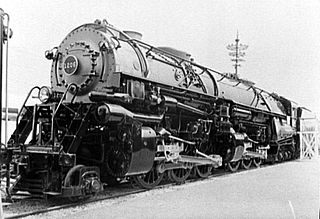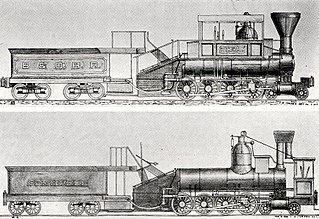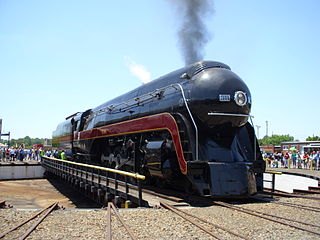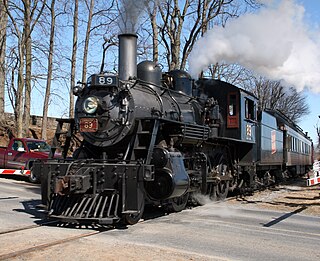
A steam locomotive is a type of railway locomotive that produces its pulling power through a steam engine. These locomotives are fuelled by burning combustible material—usually coal, wood, or oil—to produce steam in a boiler. The steam moves reciprocating pistons which are mechanically connected to the locomotive's main wheels (drivers). Both fuel and water supplies are carried with the locomotive, either on the locomotive itself or in wagons (tenders) pulled behind.

A tender or coal-car is a special rail vehicle hauled by a steam locomotive containing its fuel and water. Steam locomotives consume large quantities of water compared to the quantity of fuel, so their tenders are necessary to keep them running over long distances. A locomotive that pulls a tender is called a tender locomotive. Locomotives that do not have tenders and carry all their fuel and water on board the locomotive itself are called tank locomotives.

Rail terminology is a form of technical terminology. The difference between the American term railroad and the international term railway is the most significant difference in rail terminology. There are also others, due to the parallel development of rail transport systems in different parts of the world.

This article is a glossary of the main components found on a typical steam locomotive.

The Norfolk and Western Railway was a US class I railroad, formed by more than 200 railroad mergers between 1838 and 1982. It was headquartered in Roanoke, Virginia, for most of its existence. Its motto was "Precision Transportation"; it had a variety of nicknames, including "King Coal" and "British Railway of America".

In the Whyte notation for the classification of steam locomotive wheel arrangement, a 2-6-6-4 is a locomotive with a two-wheel leading truck, two sets of six driving wheels, and a four-wheel trailing truck. All 2-6-6-4s are articulated locomotives, of the Mallet or related simple articulated type.

A camelback locomotive is a type of steam locomotive with the driving cab placed in the middle, astride the boiler. Camelbacks were fitted with wide fireboxes which would have severely restricted driver visibility from the normal cab location at the rear.

Under the Whyte notation for the classification of steam locomotives, 4-8-0 represents the wheel arrangement of four leading wheels on two axles, usually in a leading truck or bogie, eight powered and coupled driving wheels on four axles and no trailing wheels. In North America and in some other countries the type was usually known as the Twelve-wheeler.

Under the Whyte notation for the classification of steam locomotives, a 4-8-8-2 is a locomotive with four leading wheels, two sets of eight driving wheels, and a two-wheel trailing truck.

The GE 44-ton switcher is a 4-axle diesel-electric locomotive built by General Electric between 1940 and 1956. It was designed for industrial and light switching duties, often replacing steam locomotives that had previously been assigned these chores. This locomotive's specific 44-short ton weight was directly related to one of the efficiencies the new diesel locomotives offered compared to their steam counterparts: reduced labor intensity. In the 1940s, the steam to diesel transition was in its infancy in North America, and railroad unions were trying to protect the locomotive fireman jobs that were redundant with diesel units. One measure taken to this end was the 1937 so-called "90,000 Pound Rule" : a stipulation that locomotives weighing 90,000 pounds (41,000 kg) – 45 short tons – or more required a fireman in addition to an engineer on common carrier railroads. Industrial and military railroads had no such stipulation. The 44-ton locomotive was born to skirt this requirement. Other manufacturers also built 44-ton switchers of center-cab configuration. 276 examples of this locomotive were built for U. S. railroads and industrial concerns, four were exported to Australia in 1944, 10 were exported to Canada, 10 were exported to Cuba, one was exported to the Dominican Republic, five were exported to France, three were exported to India, six were exported to Mexico, five were exported to Saudi Arabia, one was exported to Sweden, two were exported to Trinidad, 10 were exported to Uruguay, and 57 were built for the U. S. Military. Many remain, in service and in museums.

The Strasburg Rail Road is the oldest continuously operating railroad in the western hemisphere and the oldest public utility in the Commonwealth of Pennsylvania. Chartered in 1832, the Strasburg Rail Road Company is today a heritage railroad offering excursion trains hauled by steam locomotives and rarely diesel locomotives on 4.5 mi (7.2 km) of track in Pennsylvania Dutch Country, as well as providing freight service to area shippers. The railroad's headquarters are outside Strasburg, Pennsylvania.

Southern Pacific 4294 is a class "AC-12" 4-8-8-2 Cab forward type steam locomotive that was owned and operated by the Southern Pacific Railroad (SP). It was built by the Baldwin Locomotive Works in March 1944 and was used hauling SP’s trains over the Sierra Nevada, often working on Donner Pass in California. Today it is preserved at the California State Railroad Museum (CSRM) in Sacramento, California.

The Norfolk and Western J class was a class of fourteen 4-8-4 "Northern" streamlined steam locomotives built by the railway's own Roanoke Shops located in Roanoke, Virginia from 1941 to 1950 and operated by the Norfolk and Western Railway (N&W) in revenue service until the late 1950s.

Strasburg Rail Road No. 90 is a 2-10-0 "Decapod" type steam locomotive owned and operated by the Strasburg Rail Road outside of Strasburg, Pennsylvania. Built by the Baldwin Locomotive Works in 1924, No. 90 originally pulled sugar beet trains for the Great Western Railway of Colorado. In 1967, No. 90 was sold to the Strasburg Rail Road where it now resides and operates today for use on excursion trains. Today, No. 90 is one of only two operational Decapod type steam locomotives in America, the other being Frisco No. 1630 at the Illinois Railway Museum in Union, Illinois.

A Triplex locomotive is a steam locomotive that divides the driving force on its wheels by using three pairs of cylinders rigidly mounted to a single locomotive frame. Inevitably any such locomotive will be articulated. All the examples that have been produced have been of the Mallet type but with one extra set of driving wheels under the tender.

The Norfolk and Western Railway's M, M1 and M2 classes were a series of 4-8-0 steam locomotives owned and operated by the Norfolk and Western Railway. These were the last significant deliveries of 4-8-0s in the United States. The N&W needed to get coal shipments over a mountain range, and powerful locomotives were needed. 4-8-0s were chosen over 2-8-2s because the 4-8-0 had better adhesive weight. Thus, in 1906, the first of the most numerous American class of 4-8-0 was contracted and built by Baldwin. The M1 class only differed from the M in valve gear. Because the M1's valve gear was poorly designed, there was excessive wear, making it impossible to keep them in alignment and valves properly set. The M1's were the first to be retired which led to the M2 class engines with a better designed valve gear with less excessive wear.

Norfolk and Western 611 is a preserved class "J" 4-8-4 "Northern" type steam locomotive built and operated by the Norfolk and Western Railway from 1950 to 1959. Built at the Roanoke Shops in May 1950, No. 611 is the only surviving example of fourteen class "J" locomotives and currently one of many operating 4-8-4 "Northern" type locomotives in the United States.

Strasburg Rail Road No. 89 is a 2-6-0 "Mogul" type steam locomotive originally built by the Canadian Locomotive Company in February 1910 for the Canadian National Railway. It is now owned and operated by the Strasburg Rail Road outside of Strasburg, Pennsylvania where it resides today for use on excursion trains.

Strasburg Rail Road No. 7312, also known as Strasburg Rail Road No. 31, is an 0-6-0 "Switcher" type steam locomotive originally built by the Baldwin Locomotive Works in August 1908 for the Canadian National Railway. It is owned and previously operated by the Strasburg Rail Road outside of Strasburg, Pennsylvania. As of 2021, No. 7312 is currently undergoing restoration back to operating condition, however, the restoration progress has currently been put on hold for the foreseeable future.

Norfolk and Western Railway No. 433 is a preserved class M 4-8-0 "Mastodon" type steam locomotive built by the American Locomotive Company's Richmond Locomotive Works in January 1907 for the Norfolk and Western Railway. It was one of 125 M Class engines in operation on the N&W for around 50 years. After surviving an accident in 1951, the 433 was rebuilt and worked in Bristol, Virginia for a time where he was also assigned as a back up locomotive for the Abingdon Branch. This "Mollie" also worked as a switcher in Roanoke, Salem, and Radford. The 433 was eventually retired in 1958 and it became one of only two M Class locomotives to survive aside from the "Lost Engines of Roanoke". It was cosmetically restored in 2002 and now resides as a static display along the old Virginia Creeper Trail in Abingdon.



















